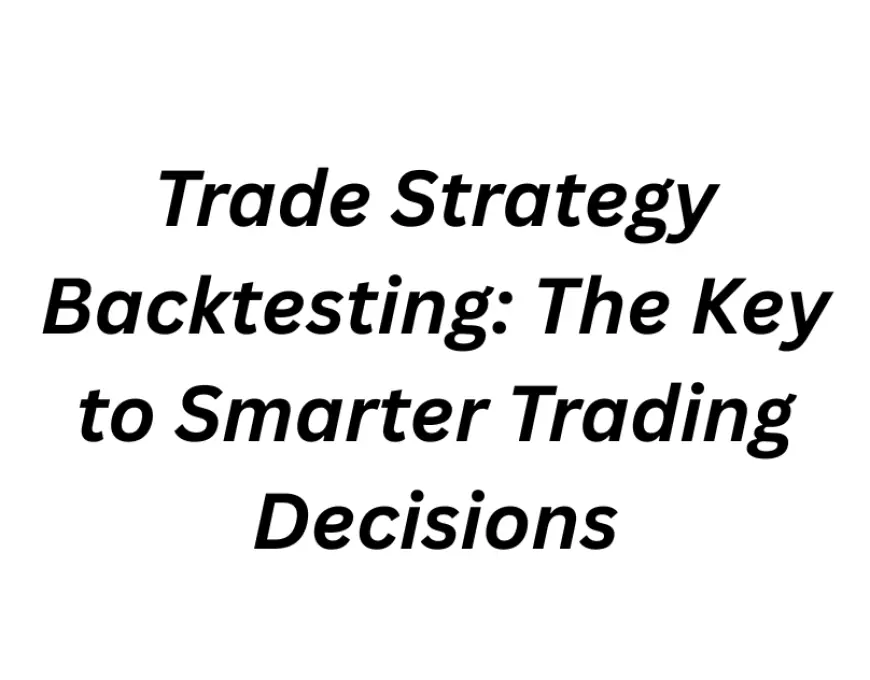Trade Strategy Backtesting: The Key to Smarter Trading Decisions
Learn how trade strategy backtesting helps traders refine their techniques, minimize risks, and improve profitability. Discover tools, steps, and real-world benefits.

In the fast-paced world of financial markets, trade strategy backtesting has emerged as an essential tool for both novice and professional traders. It allows you to test a trading strategy using historical data to see how it would have performed. This process not only helps traders gain confidence in their approach but also provides valuable insights into risk management, profitability, and optimization.
What Is Trade Strategy Backtesting?
Trade strategy backtesting is the process of evaluating a trading strategy by applying it to past market data. The goal is to determine how the strategy would have performed historically identifying both strengths and weaknesses. This simulation helps traders understand how a strategy might behave under different market conditions without risking actual capital.
By analyzing historical data, traders can make better-informed decisions and refine their strategies before using them in live markets.
Why Is Backtesting Important?
Backtesting a strategy provides multiple benefits:
-
? Risk Reduction: By identifying flaws in a strategy early, traders avoid costly mistakes in real trading.
-
? Performance Metrics: Key data points like win rate, profit factor, and drawdown are revealed.
-
? Informed Decisions: Traders can make data-backed choices instead of relying on intuition.
-
?️ Strategy Optimization: Tweaking variables in backtesting allows for stronger strategy development.
Trade strategy backtesting ultimately increases confidence in your trading plan, especially when real money is on the line.
Steps to Perform Trade Strategy Backtesting
Here's how traders typically conduct a backtest:
1. Define the Trading Strategy
Clearly outline the rules entry and exit points, indicators, timeframes, risk parameters, and position sizing.
2. Collect Historical Data
Use reliable market data for the asset and timeframe you want to test. Accuracy matters greatly here.
3. Apply the Strategy to the Data
Use either manual methods (like spreadsheets) or automated tools to simulate trades according to your strategy.
4. Analyze the Results
Evaluate KPIs such as:
-
Total return
-
Win/loss ratio
-
Average gain per trade
-
Maximum drawdown
5. Refine and Re-test
If the results are poor, tweak the strategy and re-run the backtest to see if performance improves.
Tools for Trade Strategy Backtesting
Several platforms make trade strategy backtesting simple and efficient. Popular tools include:
-
TradingView: Easy scripting with Pine Script and powerful charting tools.
-
MetaTrader 4/5: Widely used by forex traders for both backtesting and automated trading.
-
NinjaTrader: Offers advanced features for futures and equities.
-
QuantConnect: Ideal for algorithmic and data-heavy strategies in Python and C#.
-
Amibroker: Highly customizable with robust analytics for professional traders.
These tools help you automate backtesting, save time, and improve accuracy.
Limitations of Backtesting
Although powerful, trade strategy backtesting has its limitations:
-
❌ Past performance ≠ future performance: A strategy that worked before may not work now.
-
❌ Overfitting risk: Tweaking a strategy too much for historical data can reduce real-world performance.
-
❌ Slippage & commission ignorance: Some backtests don’t account for real trading costs.
-
❌ Emotional factors ignored: Human psychology during live trading is different from simulated testing.
That said, when done properly, backtesting remains an indispensable part of strategy validation.
Live Testing vs. Backtesting
After backtesting, many traders move to paper trading or forward testing trying the strategy in real-time conditions without using real money. This phase bridges the gap between historical simulation and real-world application.
Combining trade strategy backtesting with live testing offers a comprehensive evaluation of any trading approach.
Conclusion
Trade strategy backtesting empowers traders to test before they risk. Whether you're developing a new strategy or refining an existing one, backtesting provides critical insights that lead to better decision-making and potentially higher returns.
While no strategy is ever foolproof, backtesting arms you with knowledge and in trading, knowledge truly is power.
What's Your Reaction?
 Like
0
Like
0
 Dislike
0
Dislike
0
 Love
0
Love
0
 Funny
0
Funny
0
 Angry
0
Angry
0
 Sad
0
Sad
0
 Wow
0
Wow
0


















































